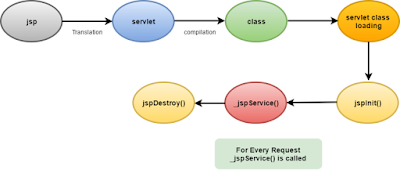JSP
Implicit Objects
JSP Implicit Objects are the Java objects that
the JSP Container makes available to developers in each page and developer can
call them directly without declaring them explicitly. These objects
are created by JSP Engine during translation phase (while translating JSP to
Servlet). They are being created inside service method so the developer can
directly use them within Scriptlet without initializing and declaring
them.
There are total 8+1 implicit objects available
in JSP.
The request Object
The request object is an instance of a javax.servlet.http.HttpServletRequest
object. Each time a client requests a page the JSP engine creates a new object
to represent that request.
The request object provides methods to get HTTP
header information including form data, cookies, HTTP methods etc.
The response Object:
The response object is an instance of a javax.servlet.http.HttpServletResponse
object. The server creates the response object to represent the response to the
client.
The out Object:
The out object is an instance of a javax.servlet.jsp.JspWriter object and
is used to send content in a response.
The JspWriter object contains most of the
methods as the java.io.PrintWriter class.
The session
Object:
The session object is an instance of javax.servlet.http.HttpSession and
behaves exactly the same way that session objects behave under Java Servlets.
The session object is used to track client
session between client requests.
The application Object:
The application object is an instance of a javax.servlet.ServletContext.
Application object is a representation of the
JSP page through its entire lifecycle. This object is created when the JSP page
is initialized and will be removed when the JSP page is removed by the
jspDestroy() method.
The config Object:
The config object is an instantiation of javax.servlet.ServletConfig.
The config object allows the JSP programmer
access to the Servlet or JSP engine initialization parameters such as the paths
or file locations etc.
The pageContext Object:
The pageContext object is an instance of javax.servlet.jsp.PageContext.
The pageContext object is used to represent the entire JSP page.
This object stores references to the request
and response objects for each request. The application, config, session, and
out objects are derived by accessing attributes of pageContext object.
The page Object:
Page object is a reference to the current
Servlet instance (Converted Servlet, generated during translation phase from a
JSP page). We can simply use this in place of it.
The exception Object
Exception object is used in exception handling
for displaying the error messages. This object is only available to the JSP
pages, which has isErrorPage set to
true.
 |
| JSP Implicit Objects |
